Heating and cooling in the EU
The EU’s heating and cooling needs in 2020 accounted for half of its total gross final energy consumption (Eurostat, 2022b). This significant share has persisted for over a decade, despite many EU and national efforts to lower heating and cooling needs[1] to meet the EU’s headline 20% energy-saving target by 2020.
Heating buildings accounts for the largest share of energy used for heating and cooling in the EU, with space and water heating accounting for about 60%, while industrial heat demand accounts for about a third of heating and cooling needs. The remaining energy used for heating and cooling is consumed in agriculture and for cooling (EC, 2022c).
In 2020, residential and industrial heating and cooling demand was only 10% below the average annual level seen from 2005 to 2009, despite the COVID-19 pandemic having suppressed industrial activity and an exceptionally mild winter having lowered the heating needs in most of Europe’s buildings (EU, 2012; EEA, 2022b). This indicates sluggish progress in achieving a permanent reduction in heating and cooling needs.
What is heat?
Heat is a valuable form of energy that supports meaningful end uses, such as the heating of residential and commercial buildings and for industrial processes. Across the EU, most energy is used to heat buildings and for industrial activities. Heat can also be used to generate electricity for various end uses, including heating. As heat is not a physical substance, it cannot easily be distinguished by origin, composition or intended use.
Buildings
With many EU countries having large stocks of old and energy-inefficient buildings, high-temperature heating systems are used to compensate for significant heat losses (EC, 2022c). Buildings consumed more than two fifths (42%) of all final energy used by all sectors in 2020, making them a main source of greenhouse gas emissions[2]. Households consumed two thirds of this energy, as illustrated in Figure 1 (Eurostat, 2022a). Historically, efficiency improvements have often coincided with higher levels of heat and electricity use in buildings, due to the increasing sizes and lower occupancy rates of dwellings, reduced energy prices, growing demand for cooling and prolonged use of more electrical equipment. In some cases, this increased use has outweighed the benefits of increased energy efficiency (SEAI, 2018; Central Statistics Office Ireland, 2022; EEA, 2022b; IPCC, 2022). Across the EU, however, the average energy consumption per household has slightly decreased since the peak of 2010, implying that energy efficiency efforts are starting to pay off (Eurostat, 2022a).
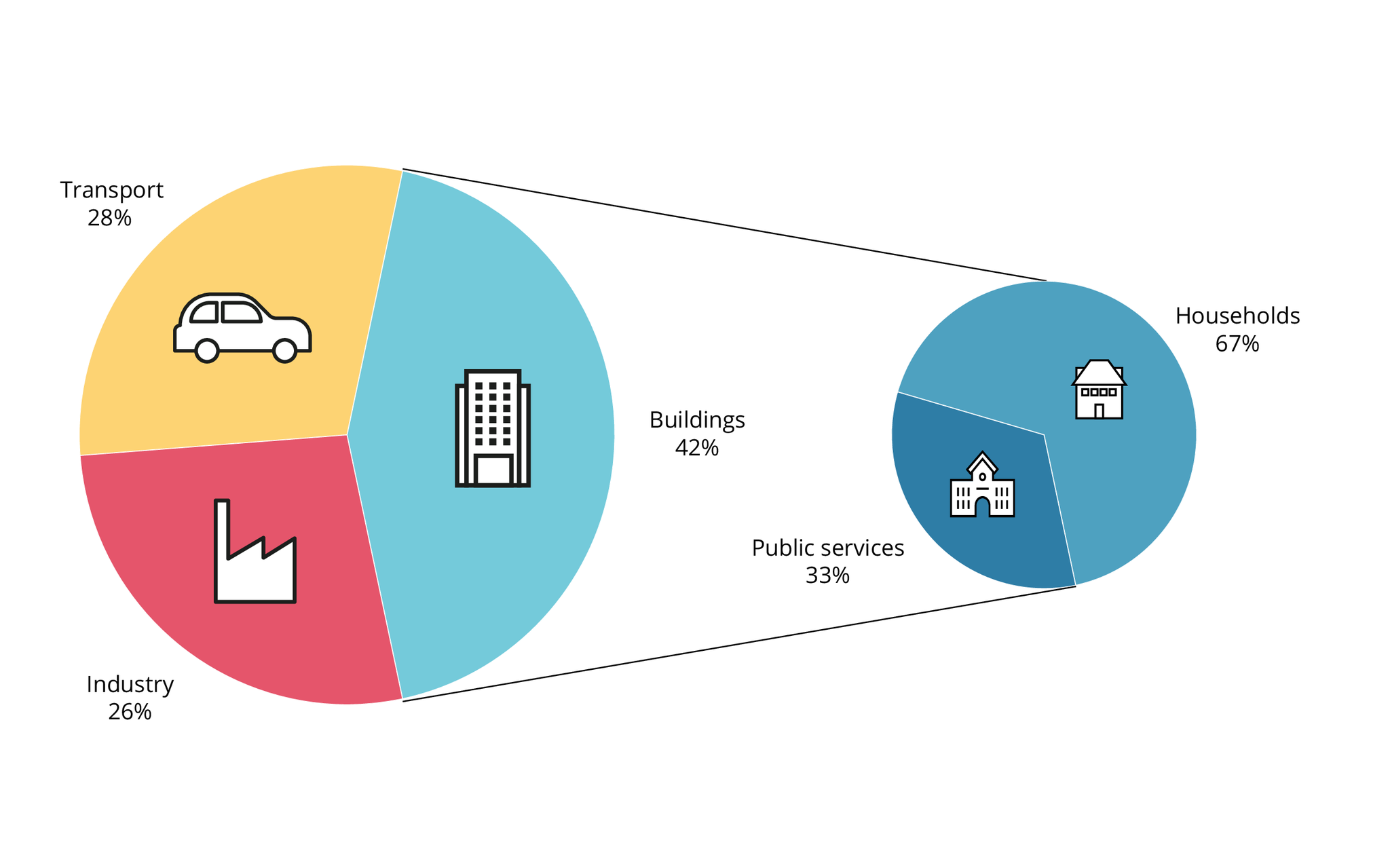
Note: Mtoe, million tonnes of oil equivalent.
Source: ESTAT (2022).
Explore different chart formats and data here
While residential cooling needs currently account for less than 1% of the total EU energy used for heating and cooling in buildings, as average temperatures continue to rise across the EU, demand for cooling is likely to increase and that of winter-related heating to decrease. Between 2012 and 2021, the mean European land temperature was already almost 2°C warmer than the pre-industrial level (EEA, 2020).
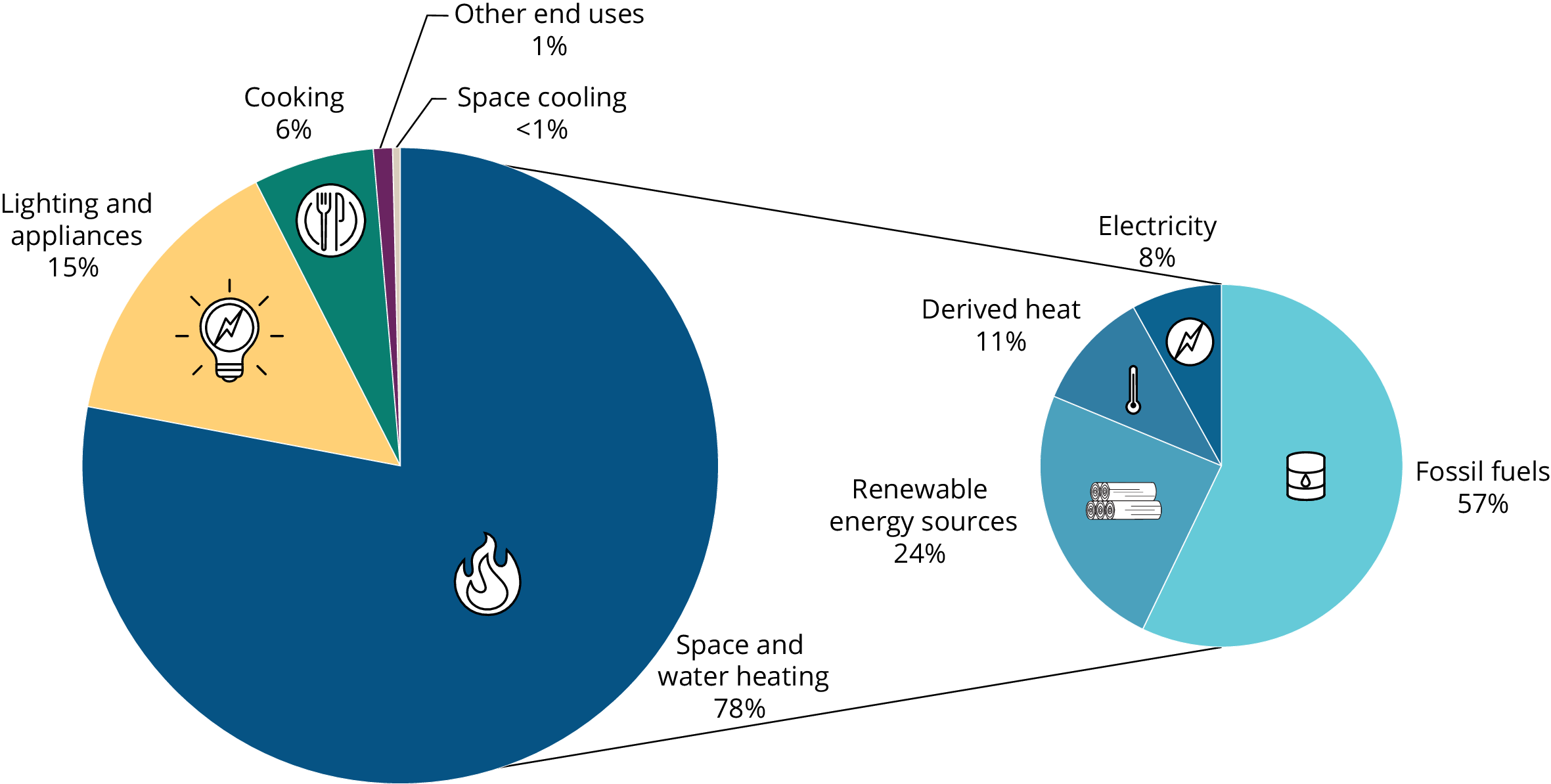
Source: ESTAT (2022).
Explore different chart formats and data here
In 2020, space and water heating accounted for four fifths (78%) of all household energy use[3]. More than half of this energy for heating (57%) was supplied by direct domestic high-temperature heating systems burning fossil fuels — notably gas (39%), oil (15%) and coal (4%) (see Figure 2).
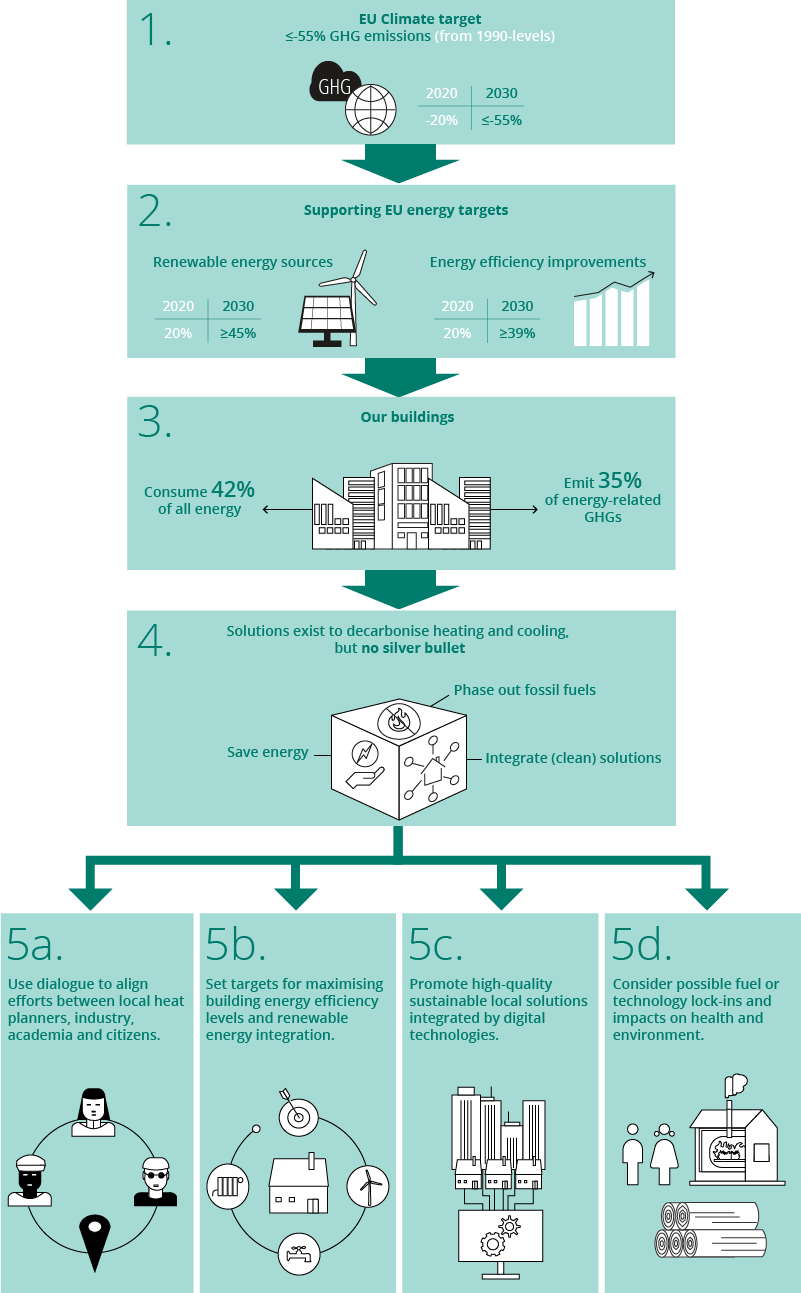
How is heat produced?
Heat is typically obtained by oxidising the chemical energy in fuels[4], converting the energy in solar radiation, extracting ambient energy from the surroundings (air, water, soil and geothermal sources) or converting electricity in heaters. It can be produced centrally, in specialised energy plants and in other enterprises from where it is piped to consumers, or heat production can be decentralised, such as when citizens, businesses and the public sector use energy to heat buildings, to produce hot water and for cooking.
Combined heat and power plants are typical examples of specialised energy industries that produce heat centrally and distribute it via pipes to end users. Other industries can also produce heat, including as a by-product, such as when heat released by exothermic chemical processes is recovered and sold to consumers.
What are renewable heat sources?
Solar thermal, geothermal and biomass fuels produced and used in a sustainable way[5] (including biogas injected into the grid and renewable municipal waste) are renewable heat sources. Ambient heat extracted from the environment by heat pumps is also a renewable heat source.
Fossil fuels also play a role upstream, when derived heat (typically hot water) and electricity are produced industrially in larger systems and supplied via grids for domestic heating. In district heating, which supplies about 10% of the EU’s heat and is more common in northern, central and eastern Europe, fossil fuels contributed more than two thirds (69%) of all fuels burned in combined heat and power plants and heat-only plants in 2020, as shown in Figure 3.
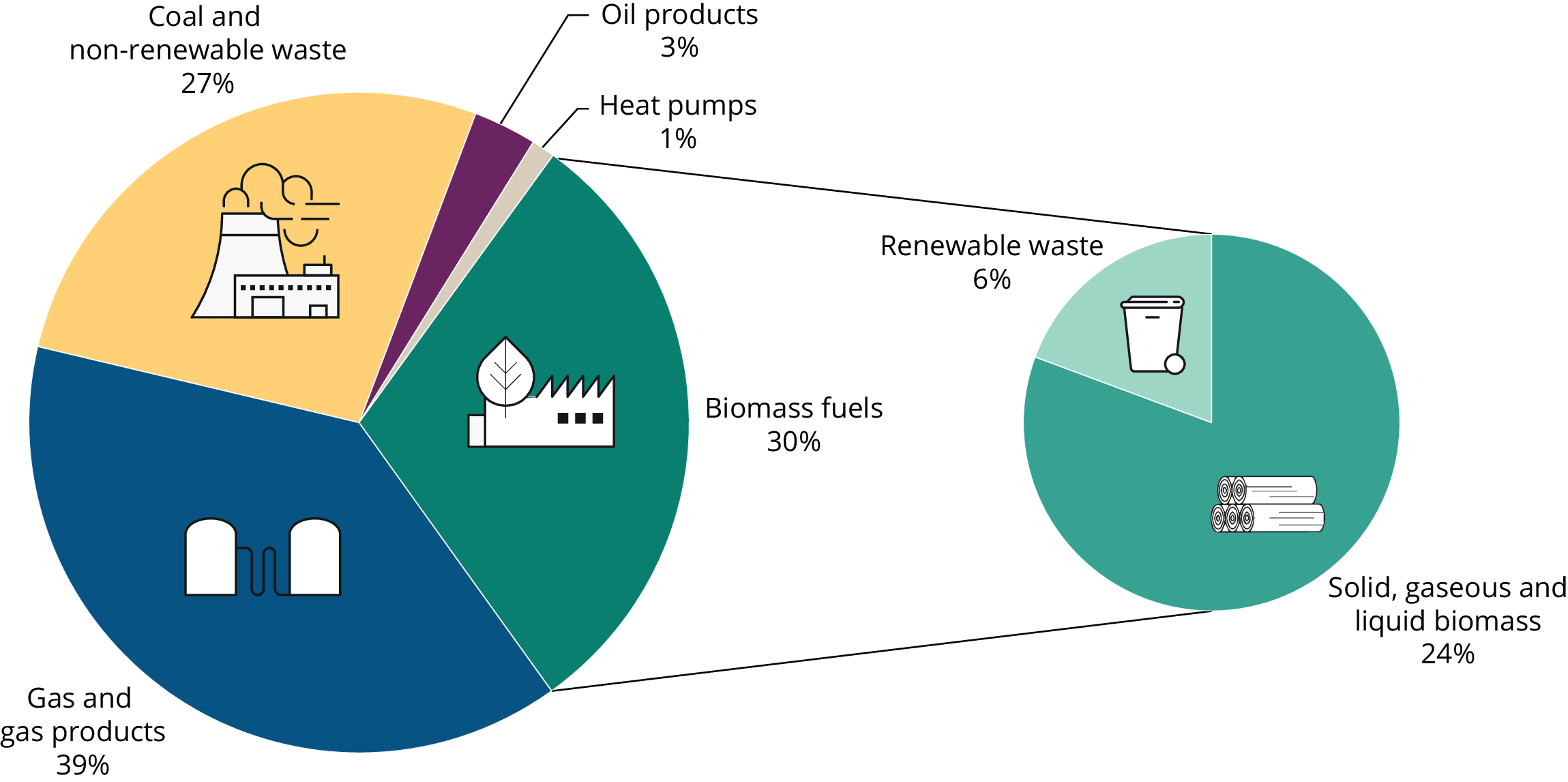
Source: ESTAT (2022).
Explore different chart formats and data here
Industry
Industrial sectors can also be important heat users. Industry currently accounts for a quarter of final energy use (see Figure 1), chiefly supplied by fossil fuels. Industrial heat demand accounts for about one third of all EU heating needs (EC, 2022c).
Even though official energy statistics do not capture comprehensively and consistently the final consumption of energy for heating and cooling per end-use sector and energy source (EC, 2022a), energy for both heating and cooling is consumed across industrial sectors, from the need for high-temperature heat in the metallurgical and ceramic industries[6], to the use of lower temperature steam and cooling agents in the food and textile industries.
Renewable energy sources in heating and cooling
In 2020, renewable energy sources accounted for only 23% of final energy used for heating and cooling from all sources in the EU. Despite this relatively small share, in absolute terms, most renewable energy used across the EU was consumed for heating and cooling due to the large demand for heating and cooling[7].
In the past 5 years, the share of renewable energy used for heating and cooling grew at a slower rate than it did from 2005 to 2015[8]. Despite this slower pace, at the EU level, the share by 2020 was still slightly higher than that expected for 2020 (22.4%) based on commitments made by Member States in 2010 in their national renewable energy action plans (see Figure 4).
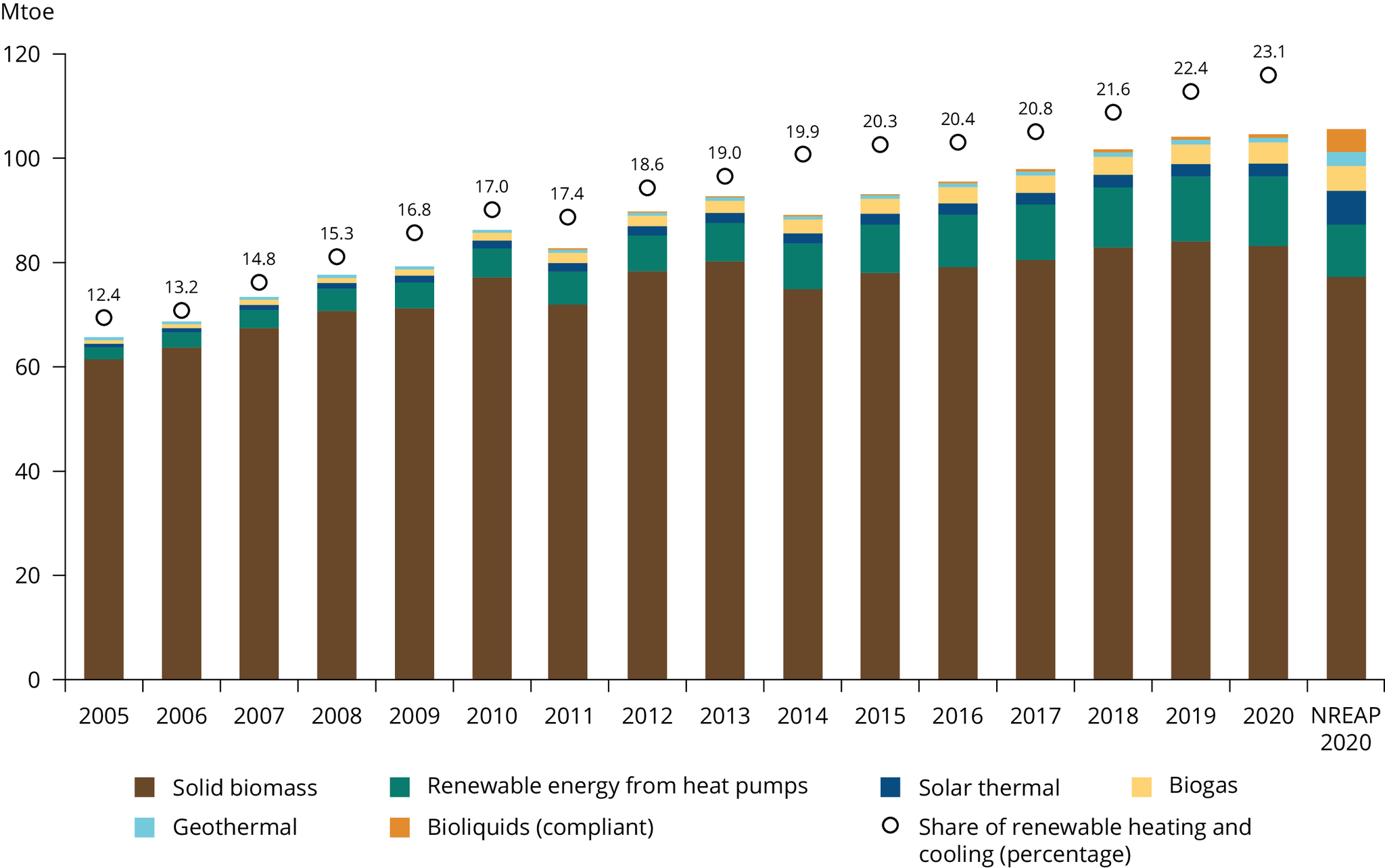
Notes: At the EU level, the actual share of renewable energy sources used for heating and cooling in 2020 (of 23.1%) was higher than the share expected for 2020 (of 22.4%) based on Member States’ national renewable energy action plans (NREAPs).
Source: EEA renewable energy data viewer.
Explore different chart formats and data here
Trends in the use of renewable energy sources for heating and cooling across end-use sectors provide two key insights. Firstly, the use of solid biomass has prevailed as main heating fuel. Solid biomass use for heating increased by over a third since 2005, accounting for 80% of all renewable energy used for heating and cooling in 2020 at the EU level[9]. A large proportion of this biomass was used by individual households in domestic heat stoves, with important possible ramifications extending to human exposure to air pollutants (EEA, 2019) and impacts on land carbon sequestration and biodiversity. Secondly, since 2005, the use of other renewable options for heating and cooling, such as heat pumps and solar thermal collectors, grew at a much faster rate than the use of solid biomass[10]. This indicates there is potential to deploy these technologies faster this decade (IEA, 2023).
Heat pumps
Through their ability to extract useful renewable energy from a variety of sources, including from city subways, wastewater treatment plants, data centres and geothermal sources, modern reversable heat pumps using refrigerants with low or very low global warming potential are emerging as a flexible approach to decarbonising heating and cooling in buildings without directly producing greenhouse gas and air pollutant emissions during use. Heat pumps can also run with variable generation sources, such as rooftop solar photovoltaic modules, to help store excess renewable electricity as heat for later use or to help modern district heating and cooling networks to become more efficient by integrating other renewable and waste energy sources for heating and cooling. The EU aims to double the rate of uptake of individual heat pumps, to reach 10 million units over the next 5 years (EC, 2022b; EEA, 2022a).
Policy measures for heating and cooling
Improving energy efficiency can provide multiple benefits to society. If policymakers duly implement the ‘energy efficiency first’ principle and direct efforts to better insulating buildings, overall heating and cooling needs will fall. This, in turn, will reduce the need for investment in heating and cooling (EC, 2022c). Improving the efficiency of building envelopes can also reduce social inequalities and help alleviate energy poverty (EEA, 2022b). Boosting the energy performance of the building stock through higher annual renovation rates, coupled with more ambitious standards for the energy performance of buildings, as envisaged by the recent recast proposal of the Energy Performance of Buildings Directive, will play a significant role in decarbonising the heating and cooling of buildings by 2030. But energy efficiency measures alone will be insufficient to decarbonise heating and cooling while fossil fuels are still being used as the main energy source (Nijs et al., 2021).
Under the post-2020 legal framework, the national climate and energy plans and investment programmes of the Member States must demonstrate that they prioritise the ‘energy efficiency first’ principle to accelerate the rate and extent of building insulation works (EC, 2021c). For energy supply, several EU measures and proposals aim to increase the use of renewable sources for heating and cooling across all Member States by 2030. These measures aim to overcome market fragmentation, harmonise national heating and cooling decarbonisation efforts, and rapidly reduce gas use. One such measure is an indicative requirement for Member States to increase their national shares of renewable energy sources used for heating and cooling by 1.1 percentage points per year, on average (EU, 2018a). More recent proposals relate to mainstreaming renewable energy deployment in buildings to reach an indicative 49% renewable energy share in final energy use in buildings across the EU. If adopted, these proposals would increase the share of renewable sources in district heating and cooling by 2.1 percentage points per year, on average, until 2030. They would also require improvements in the efficiency of co-generation systems (EC, 2021b), doubling the deployment rate of heat pumps to reach 10 million units by 2027, and accelerating the implementation of geothermal and solar thermal heating to significantly cut demand for gas in heating and cooling (EC, 2022b). Successful decarbonisation strategies for buildings for this decade require thus a combination of more ambitious energy renovation measures and a faster switch to efficient, renewable and waste sources for heating and cooling. Such measures could also help to alleviate gas price volatility and reduce air pollutant emissions.
In industry, mature approaches, such as direct electrothermal heating, heat pumps or biogas, could already be used to replace gas in the short term for medium- and low-temperature industrial heating and cooling. However, replacing fossil fuels in high-temperature processes may require renewable hydrogen supply, which currently is still a scarce resource (IPCC, 2022). Since 2021, medium- and long-term climate mitigation efforts have been compounded by an increased sense of awareness of high gas prices and supply volatility that could affect industrial competitiveness (IEA, 2023). At the gas prices that prevailed across the EU in 2021 and 2022, the attractiveness of industrial gas substitutes, including renewable hydrogen supply, has improved considerably, strengthening the economic case of the EU moving away from fossil fuels (IEA, 2023, 2022).
Prospects and challenges for 2030
For the EU and its Member States, decarbonising heating and cooling represents a major challenge on the way to meeting climate targets for 2030 and 2050 and ensuring that fundamental energy needs, such as for residential heating, can be met more securely than they are today. However, national policymakers face very different challenges and opportunities in decarbonising heating and cooling, because the availability of sustainable energy resources and the demand for heating and cooling from buildings and industry vary significantly at the country and regional levels.
To rise to the challenge, Member States will have to assess the sustainable market potentials for national, regional and local renewable energy use and waste heat and cold recovery and devise replacement schemes for fossil-fuel heating systems to increase the deployment of renewable and waste sources for heating and cooling across all sectors. For that, Member States will need to set clear end-dates for fossil fuel subsidies across all energy markets and especially in heating.
In general, adhering to the ‘energy efficiency first’ principle (EC, 2021c) can reduce buildings’ heating and cooling needs significantly[11]. Prioritising energy efficiency measures would also help the sector to meet the EU Renovation Wave target — to reduce buildings’ energy use by at least 60% by 2030. But success depends on the ability of competent authorities to drive high insulation rates, deep-energy retrofits and circular renovation actions across all buildings, and to construct zero-emission buildings[12] (EC, 2020b; EEA, 2022a).
At the same time, without an urgent move away from heating systems that use fossil fuels, it is unlikely that the EU’s climate mitigation targets for 2030 will be met (Nijs et al., 2021). On the supply side, as illustrated in Figure 5, the use of renewable energy sources must increase at a much faster rate, to meet 40% or more of the EU’s heating and cooling demand by 2030 and a minimum of 45% across all market sectors (EC, 2020a, 2022a).
Successful responses to the specific strengths and weaknesses of national and regional decarbonisation pathways will also require policymakers to set strategic research agendas and foster innovation and learning from each other. Most importantly, to implement low-emission heat and cold supply systems cost-effectively, measures will have to target faster building renovation rates, to create nearly zero- and zero-emission buildings, and to substitute fossil fuels with renewable and waste heat and cold energy sources across all sectors (EC, 2022a).
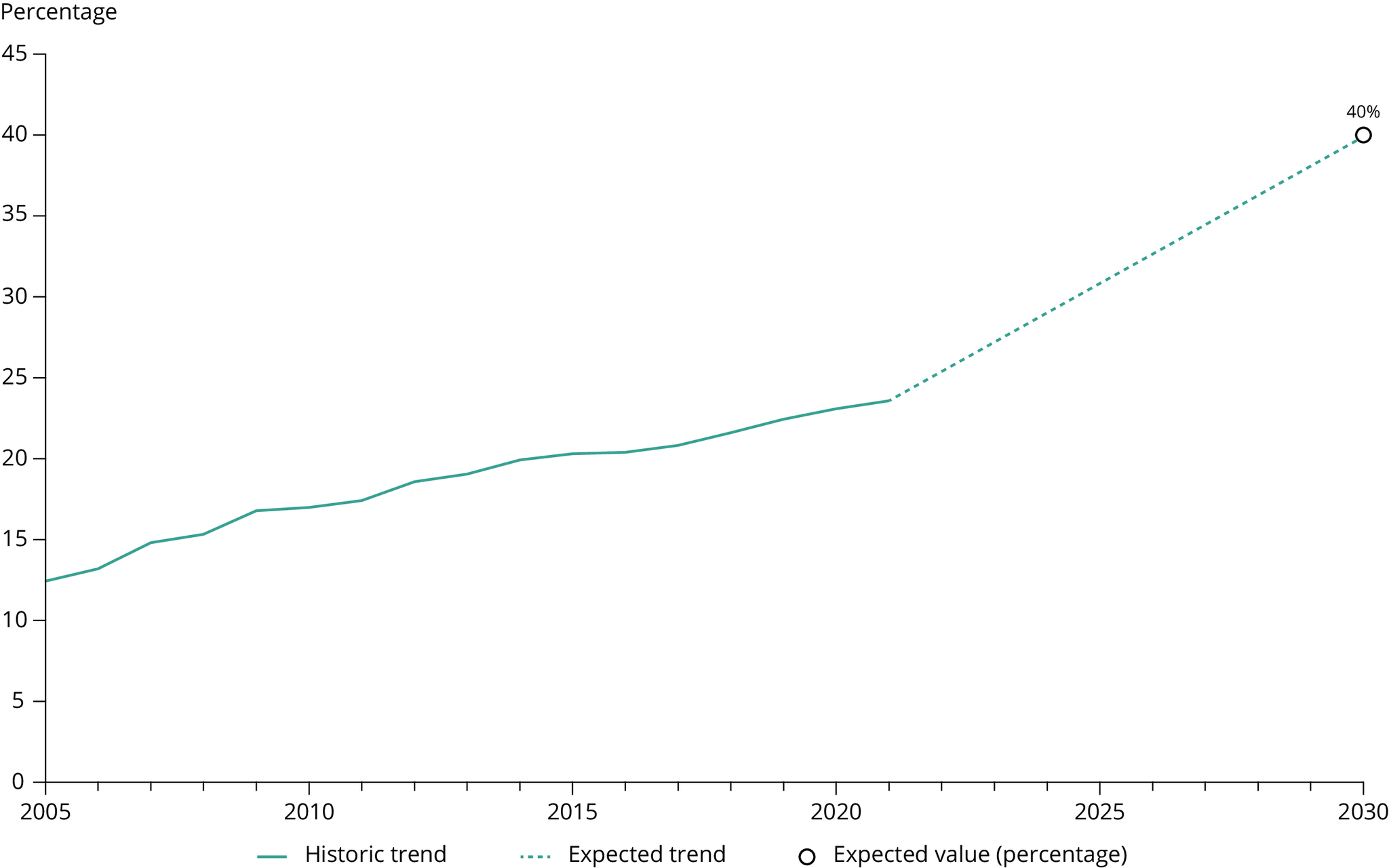
Note: The 40% share of renewable sources in final energy use for heating and cooling corresponds to the REG and MIX scenarios of the Climate Target Plan figures document. Variations of this share are marginal in the other target-reaching scenarios.
Sources: EU (2020); ESTAT (2021).
Explore different chart formats and data here
The Scandinavian and Baltic EU countries, where average heating needs are higher because of climatic factors, had already reached high shares, of more than 50%, of renewable sources in final energy consumed for heating and cooling in 2020, by utilising biomass extensively. The widespread use of modern district heating systems in these countries can facilitate the integration of low-temperature heat from geothermal and solar thermal sources and from recovered waste heat. Portugal too had reached a high share of renewable heating and cooling, of 42%, by integrating a more even mix of renewable sources that includes heat pumps, solar thermal energy and solid biomass use for heating and cooling. Further opportunities exist in all EU countries to use diverse renewable and waste sources for heating and cooling and to capitalise on digitalisation for developing a more flexible, secure and integrated energy system that encompasses heating, electricity and mobility networks.
In central and eastern Europe, many urban district heating systems are old and marred with existential challenges, ranging from inefficient heat production to network losses and a strong fossil-fuel dependence (EPG, 2022). One of the main challenges for these systems is overcoming the problems resulting from poor maintenance and abandonment. While it is possible to modernise some of these systems to reduce their running costs and environmental footprints, doing so is not simple. Finding solutions will require careful analysis of economic and environmental trade-offs, including as regards potentially more sustainable alternatives. Options for upgrading older district heating systems can be complex and costly. It can be necessary to modernise boilers, heat exchangers, heat supply networks and system controls (for instance by installing smart sensors and digital technologies) to improve a system’s reliability and performance. Insulating pipes better to reduce unintended heat loss may also be required. Further measures can include densifying and expanding the network to serve more customers and achieve economies of scale, providing new services (such as cooling), incorporating new heat networks (including for waste heat) and diversifying to renewable sources that work well in combination (such as solar thermal and photovoltaic modules and heat pumps).
Biomass, as a limited resource, needs to be managed sustainably and used in the most beneficial way to increase land carbon stocks and ecosystem services. A generalised transition from fossil to biomass fuels in homes and district heating systems may exacerbate competition for biomass feedstock. Often, such feedstock can more optimally be used to substitute more carbon-intensive building materials or petrochemical feedstock (EEA, 2019; IPCC, 2022). Although sustainable biomass fuels are a renewable source of energy, trees and other vegetation also act as a land carbon sink, by absorbing carbon dioxide from the atmosphere. Therefore, demand for biomass resources, such as for heating, needs to be carefully balanced with the necessity to increase land carbon sinks, in line with the existing legal framework for greenhouse gas emissions and removals from land use, land use change and forestry (LULUCF) in the 2030 climate and energy framework (EU, 2018b). As safeguard, the European Commission has proposed further strengthening the sustainability requirements for biomass resources that count towards the EU’s renewable energy targets (EC, 2021a). Depending on the environmental impacts of biomass feedstock production and use, solar energy modules and heat pumps can offer more sustainable alternatives for decarbonising residential heating and cooling than the combustion of biomass.
No silver bullet to decarbonise buildings — thermal retrofitting during this decade must be matched by measures to replace fossil-fuel heating systems with zero-emission and low-carbon energy sources
For buildings that use fossil fuels for heating and cooling, thermal retrofitting of the envelope is a key step towards decarbonising their energy use, but it is insufficient on its own. Further insulating such buildings helps to save energy and reduce the amount of fossil fuels used for heating and cooling. However, to successfully decarbonise the building sector in line with the EU’s climate commitments for 2030 and 2050, thermal retrofitting such buildings must be accompanied by a switch to renewables-based heating systems (Nijs et al., 2021).
Policymakers can maximise the socio-economic, health and environmental co-benefits of renewable heating and cooling strategies by assessing the possible interactions and implications of specific energy pathways, prioritising neighbourhood and systemic solutions, and providing stakeholders and consumers with information that allows them to make optimal choices (EEA, 2022a, 2019).
Notes
[1] For instance, by insulating homes so that they use less energy.
[2] In 2020, buildings accounted for 42% of the EU’s final energy use and emitted roughly 35% of the energy-related EU greenhouse gas emissions by burning fossil fuels directly and by consuming energy in the form of electricity, heating and cooling (EEA, 2021, 2022c).
[3] From fossil fuels such as gas, oil or coal, renewable fuels such as biomass and biogas, or waste.
[4] The recast Renewable Energy Directive (Directive (EU) 2018/2001) puts forward specific sustainability and greenhouse gas emission saving requirements for biomass fuels used for compliance with renewable energy targets. A draft implementing act seeks to enhance these sustainability requirements further, including by prohibiting the sourcing of biomass from primary and highly biodiverse forests (EC, 2021a).
[5] Other end uses tend to account for much lower shares of household energy use, such as lighting and appliances (15% in 2020), cooking (6%) and space cooling and other uses (1%).
[6] Glass manufacturing industries typically use gas to heat up melting furnaces, while blast furnaces require temperatures above 700°C to reduce iron ore.
[7] Renewable heating and cooling amounted to about half of all gross final renewable energy use in 2020. The consumption of renewable energy sources for electricity and transport makes up the other half (Eurostat, 2022b).
[8] At 0.6 percentage points per year, on average, compared with 0.8 percentage points per year.
[9] In 2020, according to the Eurostat SHARES results, biomass fuels deemed compliant with the Renewable Energy Directive and consumed for heating and cooling consisted foremost of solid biomass fuels (83 million tonnes oil equivalent (Mtoe), including renewable municipal waste), followed by biogas (4.1Mtoe) and other biomass fuels (0.7Mtoe). The use of renewable energy from heat pumps, solar thermal energy and geothermal energy accounted for much lower shares in the sector (of 13%, 2% and 1%, respectively).
[10] For instance, renewable energy use from heat pumps has increased sixfold since 2005, accounting for 13% of the renewable energy used for heating and cooling in the EU by 2020.
[11] According to the EU Climate Target Plan assessment, policy measures to improve the thermal insulation of buildings could reduce heating and cooling needs by between 28% and 31% in the residential sector and 7% and 9% in services, compared with 2005 (EC, 2022a).
[12] The recast proposal of the Energy Performance of Buildings Directive (COM (2021) 802 final) promotes the improvement of the energy performance of buildings and a reduction in greenhouse gas emissions with the objective of achieving a zero-emission building stock across the EU by 2050. Zero-emission buildings are understood to be buildings with a very high energy performance that do not generate emissions from the energy they use, are supplied by renewable sources and may be also able to export renewable energy to the grid.
References
Central Statistics Office Ireland, 2022, ‘Energy’ (https://www.cso.ie/en/statistics/energy/) accessed 28 November 2022.
Copernicus Land Monitoring Service, 2021, ‘Copernicus: 2020 warmest year on record for Europe; globally, 2020 ties with 2016 for warmest year recorded’ (https://climate.copernicus.eu/copernicus-2020-warmest-year-record-europe-globally-2020-ties-2016-warmest-year-recorded) accessed 25 November 2022.
EC, 2020a, Commission Staff Working Document ‘Impact assessment accompanying the document Communication from the Commission to the European Parliament, the Council, the European Economic and Social Committee and the Committee of the Regions — Stepping up Europe’s 2030 climate ambition: investing in a climate-neutral future for the benefit of our people’ (SWD(2020) 176 final).
EC, 2020b, Communication from the Commission to the European Parliament, the Council, the European Economic and Social Committee and the Committee of the Regions ‘A renovation wave for Europe: greening our buildings, creating jobs, improving lives’ (COM(2020) 662 final).
EC, 2021a, ‘Biomass’ (https://energy.ec.europa.eu/topics/renewable-energy/bioenergy/biomass_en) accessed 8 December 2022.
EC, 2021b, Proposal for a Directive of the European Parliament and of the Council amending Directive (EU) 2018/2001 of the European Parliament and of the Council, Regulation (EU) 2018/1999 of the European Parliament and of the Council and Directive 98/70/EC of the European Parliament and of the Council as regards the promotion of energy from renewable sources, and repealing Council Directive (EU) 2015/652 (COM(2021) 557 final).
EC, 2021c, Proposal for a Directive of the European Parliament and of the Council on energy efficiency (recast) (COM(2021) 558 final).
EC, 2022a, Commission Staff Working Document ‘Implementing the REPower EU action plan: investment needs, hydrogen accelerator and achieving the bio-methane targets’ (SWD(2022) 230 final).
EC, 2022b, Communication from the Commission to the European Parliament, the European Council, the Council, the European Economic and Social Committee and the Committee of the Regions ‘REPowerEU plan’ (COM (2022) 230 final).
EC, 2022c,Policy support for heating and cooling decarbonisation: roadmap, European Commission Directorate-General for Energy (https://op.europa.eu/en/publication-detail/-/publication/f5118ffc-eabd-11ec-a534-01aa75ed71a1/language-en) accessed 25 November 2022.
EEA, 2019,Renewable energy in Europe: key for climate objectives, but air pollution needs attention, EEA Briefing No 13/2019, European Environment Agency (https://www.eea.europa.eu/publications/renewable-energy-in-europe-key) accessed 28 April 2021.
EEA, 2020, ‘Global and European temperatures’, European Environment Agency (https://www.eea.europa.eu/data-and-maps/indicators/global-and-european-temperature-10/assessment) accessed 12 March 2020.
EEA, 2021, ‘Greenhouse gas emissions from energy use in buildings in Europe’, European Environment Agency (https://www.eea.europa.eu/data-and-maps/indicators/greenhouse-gas-emissions-from-energy/assessment) accessed 13 July 2022.
EEA, 2022a, ‘Building renovation: where circular economy and climate meet’, European Environment Agency (https://www.eea.europa.eu/publications/building-renovation-where-circular-economy) accessed 10 October 2022.
EEA, 2022b, ‘Cooling buildings sustainably in Europe: exploring the links between climate change mitigation and adaptation, and their social impacts’, European Environment Agency (https://www.eea.europa.eu/publications/cooling-buildings-sustainably-in-europe) accessed 28 November 2022.
EEA, 2022c,Trends and projections in Europe 2022, EEA Report No 10/2022, European Environment Agency (https://www.eea.europa.eu/publications/trends-and-projections-in-europe-2022) accessed 18 December 2022.
EPG, 2022,District heating in national long-term strategies: Member States’ visions for enabling low-carbon district heat networks, Energy Policy Group (https://www.enpg.ro/wp-content/uploads/2022/11/EPG_District_Heating_Report.pdf) accessed 28 November 2022.
EU, 2012, Directive 2012/27/EU of the European Parliament and of the Council of 25 October 2012 on energy efficiency, amending Directives 2009/125/EC and 2010/30/EU and repealing Directives 2004/8/EC and 2006/32/EC (OJ L 315, 14.11.2012, p. 1-56).
EU, 2018a, Directive (EU) 2018/2001 of the European Parliament and of the Council of 11 December 2018 on the promotion of the use of energy from renewable sources (recast) (OJ L 328, 21.12.2018, p. 82-209).
EU, 2018b, Regulation (EU) 2018/841 of the European Parliament and of the Council of 30 May 2018 on the inclusion of greenhouse gas emissions and removals from land use, land use change and forestry in the 2030 climate and energy framework, and amending Regulation (EU) No 525/2013 and Decision No 529/2013/EU (OJ L 156, 19.6.2018, p. 1-25).
Eurostat, 2022a, ‘Energy data’ (https://ec.europa.eu/eurostat/web/energy/data) accessed 28 November 2022.
Eurostat, 2022b, ‘Shares summary results 2020’ (https://ec.europa.eu/eurostat/web/energy/data/shares) accessed 6 May 2022.
IEA, 2022, ‘Global Hydrogen Review 2022’,.
IEA, 2023, ‘Energy Technology Perspectives 2023’, Energy Technology Perspectives.
IPCC, 2022,Climate change 2022: mitigation of climate change, Intergovernmental Panel on Climate Change (https://www.ipcc.ch/report/sixth-assessment-report-working-group-3/) accessed 28 November 2022.
IRENA, 2022,World energy transitions outlook: 1-5°C pathway, International Renewable Energy Agency (https://www.irena.org/publications/2022/mar/world-energy-transitions-outlook-2022) accessed 28 November 2022.
Nijs, W., et al., 2021,EU challenges of reducing fossil fuel use in buildings, JRC Science for Policy Report, JRC127122, Joint Research Centre (https://publications.jrc.ec.europa.eu/repository/handle/JRC127122) accessed 7 December 2022.
SEAI, 2018,Energy in the residential sector, Sustainable Energy Authority of Ireland (https://www.seai.ie/publications/Energy-in-the-Residential-Sector-2018-Final.pdf) accessed 28 November 2022.
Trewin, B., et al., 2022, ‘Headline indicators for global climate monitoring’,Bulletin of the American Meteorological Society102(1), pp. E20-E37 (DOI: 10.1175/BAMS-D-19-0196.1).
Identifiers
Briefing no. 27/2022
Title: Decarbonising heating and cooling — a climate imperative
EN HTML: TH-AM-22-025-EN-Q - ISBN: 978-92-9480-525-6 - ISSN: 2467-3196 - doi: 10.2800/060357
EN PDF: TH-AM-22-025-EN-N - ISBN: 978-92-9480-524-9 - ISSN: 2467-3196 - doi: 10.2800/515288






Document Actions
Share with others